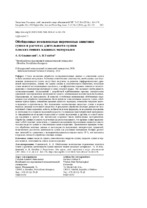| dc.contributor.author | Ольшанский, А. И. | |
| dc.contributor.author | Голубев, А. Н. | |
| dc.coverage.spatial | Минск | ru |
| dc.date.accessioned | 2024-08-09T07:28:15Z | |
| dc.date.available | 2024-08-09T07:28:15Z | |
| dc.date.issued | 2024 | |
| dc.identifier.citation | Ольшанский, А. И. Обобщенные комплексные переменные кинетики сушки в расчетах длительности сушки плоских тонких влажных материалов = Generalized Complex Variables of Drying Kinetics in Calculations of Drying Duration of Flat Thin Wet Materials / А. И. Ольшанский, А. Н. Голубев // Известия высших учебных заведений и энергетических объединений СНГ. Энергетика. – 2024. – № 4. – С. 363-376. | ru |
| dc.identifier.uri | https://rep.bntu.by/handle/data/147715 | |
| dc.description.abstract | Статья посвящена обработке экспериментальных данных в отношении сушки тонких влажных материалов. Расчетные кинетические зависимости, необходимые для определения длительности сушки, могут быть получены из решения дифференциальных уравнений массопереноса, однако эта задача сложна в аналитическом отношении, поскольку сушка является нестационарным процессом, а коэффициенты переноса зависят от влагосодержания и температуры материала в очень сложной форме. Это вызывает необходимость экспериментальных исследований с разработкой приближенных простых эмпирических уравнений для определения длительности сушки с минимальным количеством постоянных, определяемых из эксперимента. В качестве устойчивых комплексных обобщенных переменных при обработке эксперимента были приняты: относительная скорость сушки, обобщенное время сушки, отношение времени сушки по периодам, отношение текущего влагосодержания к критическому. Все переменные взаимосвязаны скоростью сушки в первом периоде (периоде постоянной скорости). В результате обработки опытных данных по конвективной сушке керамики, асбеста, войлока получены формулы, позволяющие определить ее длительность в периоде падающей скорости. Создаваемая такой обработкой эксперимента инвариантность позволяет переходить от одних переменных к другим, от одной системы координат к другой, что значительно сокращает число необходимых экспериментов. Обработка данных и анализ полученных формул показывают, что кривые сушки представляют собой сложные экспоненты, а главными связующими переменными являются относительная скорость сушки и относительное влагосодержание. Представлена проверка точности обработки опытных данных и достоверности полученных эмпирических уравнений, позволяющих рассчитать длительность сушки для указанных материалов. Разброс расчетных значений по сравнению с экспериментальными составляет около 10 %, что находится в пределах точности обработки опытных данных. | ru |
| dc.language.iso | ru | ru |
| dc.publisher | БНТУ | ru |
| dc.title | Обобщенные комплексные переменные кинетики сушки в расчетах длительности сушки плоских тонких влажных материалов | ru |
| dc.title.alternative | Generalized Complex Variables of Drying Kinetics in Calculations of Drying Duration of Flat Thin Wet Materials | ru |
| dc.type | Article | ru |
| dc.identifier.doi | 10.21122/1029-7448-2024-67-4-363-376 | |
| local.description.annotation | The article is devoted to the processing of experimental data regarding the drying of thin wet materials. The calculated kinetic dependencies necessary to determine the drying duration can be obtained from solving differential mass transfer equations, but this task is analytically complex, since drying is a non-stationary process, and the transfer coefficients depend on the moisture content and temperature of the material in a very complex form. This necessitates experimental studies with the development of approximate simple empirical equations for determining the drying duration with a minimum number of constants determined from the experiment. When processing the experiment, the relative drying rate, generalized drying time, the ratio of drying time by periods and the ratio of the current moisture content to the critical one were accepted as stable complex generalized variables when processing the experiment. All variables are interrelated by the drying rate in the first period (the period of constant rate). As a result of processing experimental data on convective drying of ceramics, asbestos, felt, formulas were obtained that make it possible to determine its duration in the period of falling rate. The invariance caused by such experimental processing allows one to move from one variable to another, from one coordinate system to another, which significantly reduces the number of necessary experiments. Data processing and analysis of the resulting formulas shows that the drying curves are complex exponentials, and the main mediating variables are the relative drying rate and relative moisture content. Verification of the accuracy of experimental data processing and the reliability of the obtained empirical equations, which make it possible to calculate the drying duration for the specified materials, is presented. The spread of the calculated values compared to the experiment is about 10 %, which is within the accuracy of experimental data processing. | ru |

